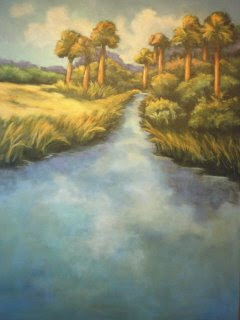
Summer Silouette
30x40
Sold
One composition decision that deserves some discussion is the rule of thirds. It’s a very simplified version of the Golden Ratio. Dividing something into one third, two thirds is very pleasing to our eye, and is an easy way to make sure the compositional balance of your painting will work. This can apply to any painting, but I’ll describe it through the landscape here.
If you are planning to focus on the sky, make sure it has the larger, two thirds portion of the canvas. If your painting will be mostly about the land, make that the two-third portion. Let’s say the land will have the larger portion. Divided that portion into the foreground, middle and background, make sure the one you want to focus on gets almost two thirds of the space.
Carry this rule of thirds out on every decision in your painting. One third above middle gray in value, two-thirds below. One third of the colors cool, and two thirds warm. One third in sunlight, two thirds in shadow. One third complement, two thirds dominant color.
Pushing the ratios even father leads to more interesting composition. Use this information as a tool, not a formula. But if you have a painting that isn't quite working, applying the rule of thirds can sometimes help you towards a solution.
If you are planning to focus on the sky, make sure it has the larger, two thirds portion of the canvas. If your painting will be mostly about the land, make that the two-third portion. Let’s say the land will have the larger portion. Divided that portion into the foreground, middle and background, make sure the one you want to focus on gets almost two thirds of the space.
Carry this rule of thirds out on every decision in your painting. One third above middle gray in value, two-thirds below. One third of the colors cool, and two thirds warm. One third in sunlight, two thirds in shadow. One third complement, two thirds dominant color.
Pushing the ratios even father leads to more interesting composition. Use this information as a tool, not a formula. But if you have a painting that isn't quite working, applying the rule of thirds can sometimes help you towards a solution.






